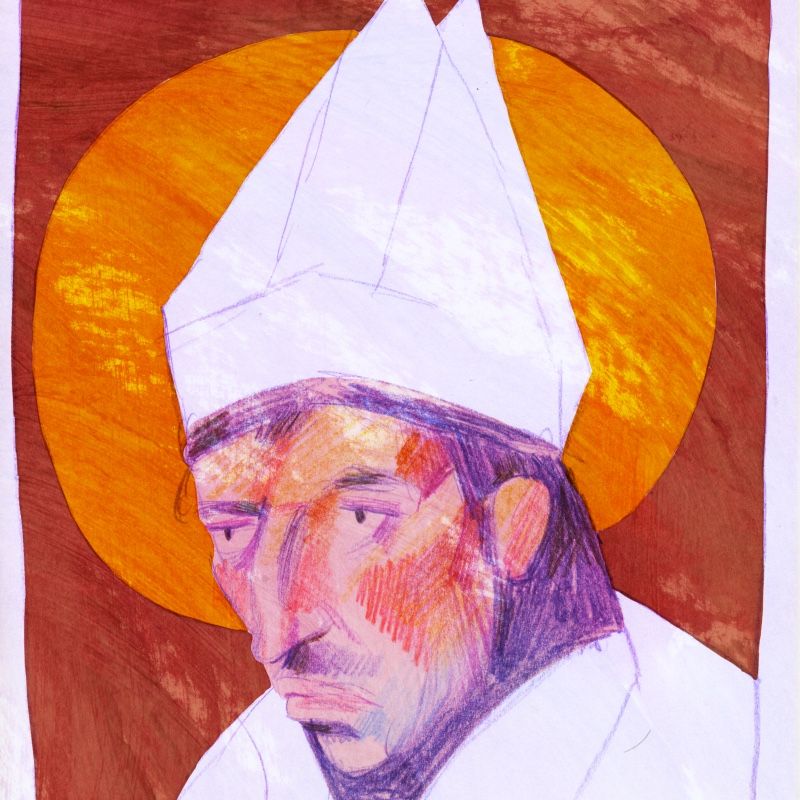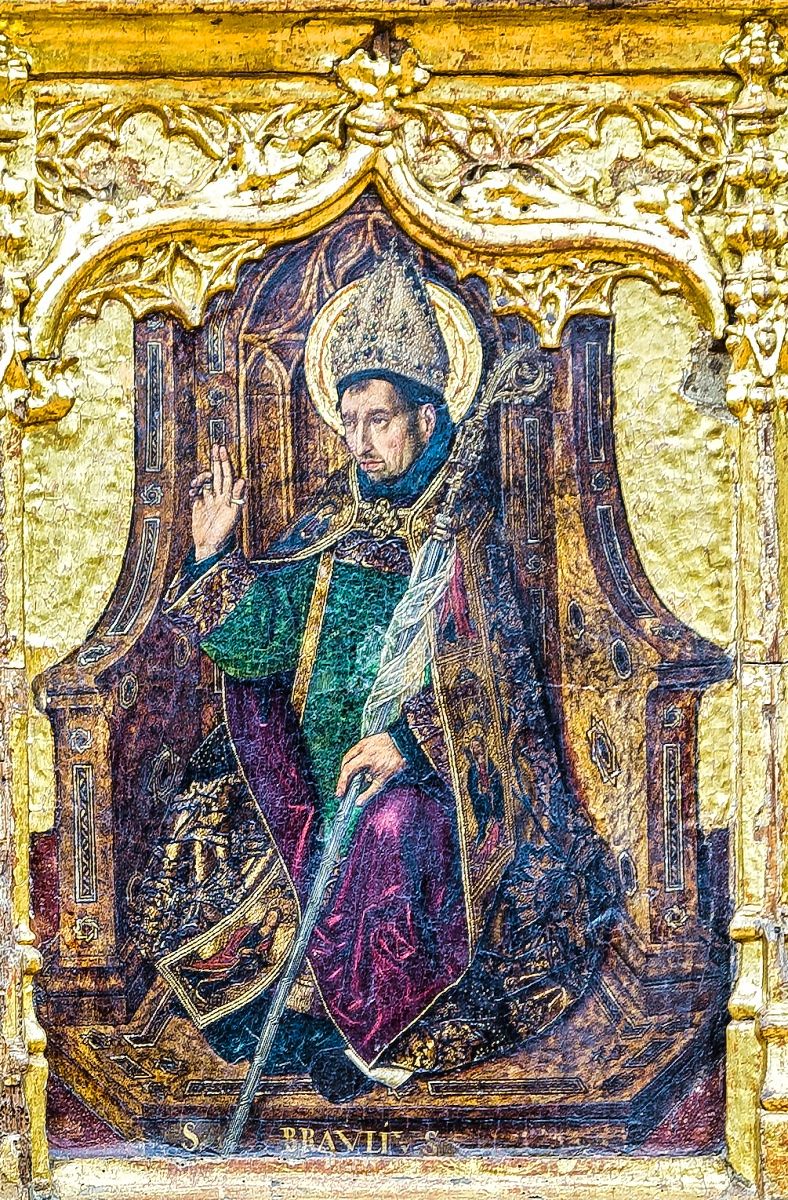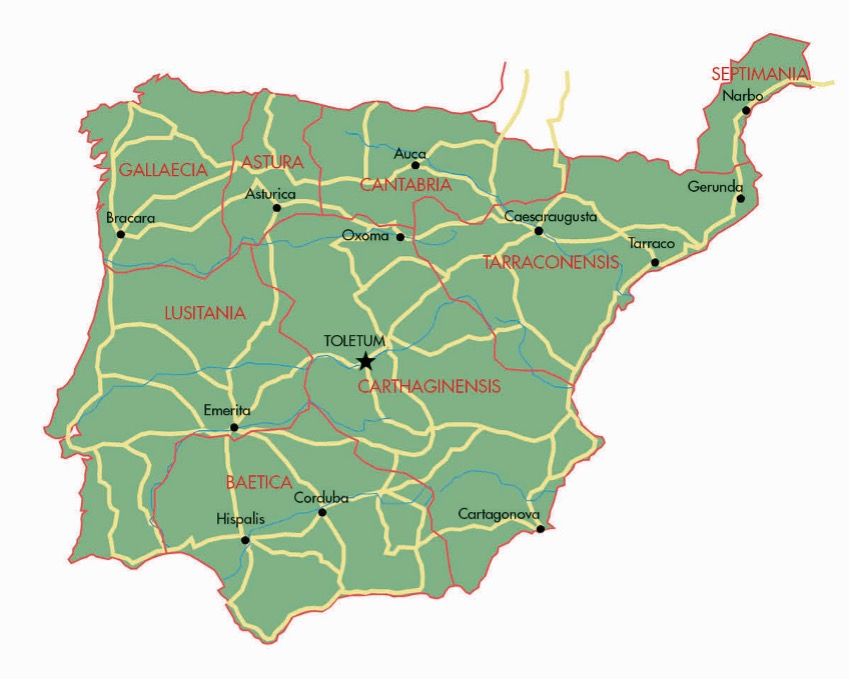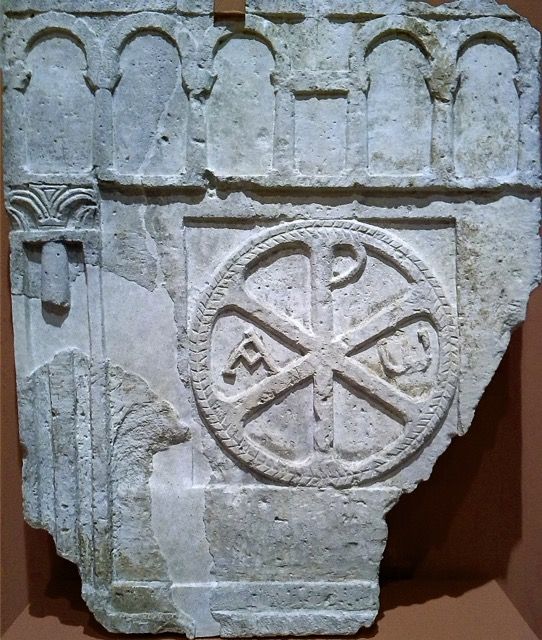saint braulio
A bridge between Antiquity and the Middle Ages
Circa 585 – Saragossa, 651
It is not clear where Braulio was born. Nor when. Some say he was born in the town of Osma, not far from Soria, where his father was stationed. Others say he was born in what is now part of Catalonia. And there are those who are convinced that he was born in the capital of the Ebro. What is certain is that he spent the most flourishing years of his life as bishop of Saragossa, from where he became one of the most influential figures in Hispania in the 7th century, during the turbulent rule of the Visigoth kings.

The Visigoths were a Germanic people who were initially enemies of the Romans, and their king Alaric even ruthlessly sacked Rome in 410. But they soon adopted some Roman customs, including the Christian religion, and became military allies. They settled in the south of present-day France, took part in the defeat of Attila’s fearsome Huns, and were commissioned by the Roman emperors to rid Hispania of other Germanic peoples who had invaded it. After the demise of the Western Roman Empire, they created an independent kingdom on the Iberian Peninsula, with Toledo as its capital.
In the cities of their kingdom, the Visigoth nobles had political and military control, while the bishops, in addition to religious functions, took on judicial, administrative, cultural and educational functions… Almost all the ecclesiastical leaders came from the Hispano-Roman aristocracy. And sometimes they formed part of veritable dynasties. For example, Braulio’s father, Gregorio, was bishop of Osma; his brother Juan, bishop of Saragossa before him; another of his brothers, Frominiano, abbot of the Riojan monastery of San Millán; and his sister Pomponia, abbess of a women’s convent.
Braulio was appointed bishop in 631 and thanks to his overflowing capacity for work he made Saragossa an outstanding city. He shone among the dignitaries of the Hispanic Church and, with the support of other prelates, even went so far as to oppose the claims of the brutal Pope Honorius I, who was in favour of punishing Jews who did not convert to Christianity with excessive harshness.
He was the right-hand man of two monarchs, Chindasvinto and Recesvinto, whom he helped to bring stability to a fragile kingdom, involved in armed conflicts every time a new king had to be appointed, as there was no direct succession to the throne from father to son and the sovereigns were elected in an assembly by nobles with conflicting ambitions and interests. Such was his prestige that King Recesvinto asked him to correct and order a complete set of laws, the so-called Liber Iudiciorum, to be applied equally to Visigoths and Hispano-Romans, something which had not been the case until then.

During Braulio’s mandate, Saragossa stood out as an active cultural centre. On the banks of the Ebro he established a cathedral school to train young people and built up a large library, one of the largest in Christendom, which included classical works by Greek and Roman authors, together with others on ecclesiastical subjects. As the books were unique pieces that had to be reproduced by hand, as there was no printing press, to increase his collection he ordered copies of those he lacked from other places, including Rome, which he exchanged for copies of those he already owned.
He also persuaded his teacher, Isidor of Seville, to write an encyclopaedia that would bring together the knowledge of antiquity before it was lost and which was entitled Etymologies, i.e. the origin of things. He was in charge of revising the text and distributing it in twenty books and 448 chapters covering numerous fields of knowledge (theology, history, literature, art, law, grammar, astronomy, natural sciences, etc.). This monumental work was key to the cultural development of Europe throughout the Middle Ages.
He finished writing a Latin hymn in verse, the Life of San Millán, begun by his brother Juan and which would inspire centuries later poetic compositions by Gonzalo de Berceo. In order to ensure the continuity of his work, he trained several disciples, such as Tajón, his successor as bishop, and Eugenio, who settled in Saragossa, attracted by Braulio’s fame, and after receiving his teachings was appointed archbishop of Toledo.
For his love of knowledge, Saint Braulio was elected patron saint of the University of Saragossa, which celebrates his feast day every 26 March. According to tradition, his tomb is under the main altar of the Basilica of Pilar, where mass is celebrated.
References:
- Mariví Escribano (1999): Los godos en Aragón. Zaragoza: CAI.
- Mariví Escribano y Guillermo Fatás, La Antigüedad tardía en Aragón, Zaragoza, CAI, Col. Mariano de Pano, 2001.
- Guillermo Galván (2010): Sombras de mariposa (novela). Madrid: La Esfera de los Libros.
- José Calvo Poyato (2018): El último tesoro visigodo (novela). Barcelona: Ediciones B.
- Wikipedia: https://es.wikipedia.org/wiki/Braulio_de_Zaragoza
- Gran Enciclopedia aragonesa on line: http://www.enciclopedia-aragonesa.com/voz.asp?voz_id=2550
Teaching activities
The Visigoths in Spain
The following passages describe some aspects of the Visigothic period. Look up in the text on Saint Braulio or on the web the years in which this historical period took place and find information that will allow you to answer the questions posed.
At first, the Visigothic population remained on the fringes of the Roman population. Thus, for example, mixed marriages were forbidden, due to the fact that they practised different types of Christianity: the Visigoths professed Arianism, while the Hispano-Romans practised Catholicism. The situation changed with the conversion to Catholicism of King Recaredo at the Third Council of Toledo in 589, thus eliminating the existing religious barrier.
Do you know the difference between Arianism and Catholicism?
Its form of government was monarchy. But it was an elective monarchy and not a hereditary one. It was the nobles who had to elect the king when the previous monarch died. This led to tensions and infighting for the throne and caused instability.
What kind of monarchy does Spain have today, and is it similar to the Visigothic era?
The Visigoths influenced the law and some customs. However, they accepted the Latin language (renouncing their own) and much of Roman culture. They maintained the cultural centres of the Peninsula that had been established during the Roman Empire, although they added a new one, Toledo, which was established as the capital of the kingdom.
Do you know of any words in present-day Spanish that derive from the language spoken by the Visigoths?
The Visigothic habeas corpus, contained in the Liber Iudiciorum, was the first manifestation of a fundamental right, a certain municipal autonomy, a conception of personal freedom and a complex legislation whose foundations would continue during the Middle Ages when it was translated into Romance languages.
Were the laws always the same for Visigoths and Hispano-Romans, what is the Liber Iudicorum, do you know what habeas corpus is?
The Visigothic kings
Note what is said of the Visigothic kings who reigned while St Braulio was bishop of Saragossa (631-651).
Sisenando (631-636) proclaimed himself king when he confronted Suintila. He convoked the IV Council of Toledo in 633, led by Isidor of Seville and in which St Braulio took part. At this council the first laws were promulgated which would later form the Liber Iudiciorum of Recesvinto.
Chintila (636-639) was appointed king by the nobility and the bishops, following the long-established custom. He convened the 5th Council of Toledo in 636, where he set harsh penalties for usurpers and those who attempted against the king. Later, at the 6th Council of Toledo in 638, it was legislated that the person elected king should come from the nobility.
Tulga (639-642) was elected king by an assembly of nobles and bishops. However, as his father Chintila had appointed him as his successor, his reign caused unrest among the Visigoth nobility.
Chindasvinto (642-653) drafted legislation designed to give political substance to his repressive measures, including those enacted against the clergy. He decreed that civil law was above ecclesiastical law and that the king was to be obeyed before the bishops. St. Braulio shows his concern about this issue in a letter to the bishop of Valencia. In order to avoid a succession conflict, several bishops and governors led by St Braulio persuaded the monarch to agree to the association to the throne of his son Recesvinto and then, after his death, to be his successor. They wanted the transition from one reign to another to be smooth and peaceful.
Recesvinto (653-672) sought peace with the nobles punished by his father. His most important undertaking was the promulgation of the Liber Iudiciorum in 654, already begun by his predecessors, for the drafting of which he enlisted the help of St Braulio.
Explain some of his historical contributions and your relationship with him. What characteristics would you highlight of his system of government, do you think it was too many for such a limited period, and why do you think his reigns were so short?
The Visigothic territory
The Visigoths maintained the Roman division into provinces. At the head of each province was a governor or duke with political and military responsibilities.

Mark on the map of the Visigothic kingdom in the 7th century (the Roman roads have been marked) which cities correspond to those mentioned today.
Locate on the map the places with which Saint Braulio was in contact throughout his life.
Osma: possible place of birth, as his father was bishop of this city.
Saragossa: possible place of his birth, he received the see of the bishopric of Saragossa on the death of his brother Juan, the previous bishop. He was bishop of Saragossa until his death.
Toledo: he took part in several councils in this city. He corresponded with Bishop Eugenio II of Toledo, Abbot Emiliano, protégé of King Chindasvinto, and the kings Chindasvinto and Recesvinto.
Seville: city of Saint Isidore, who was his teacher and mentor.
Braga: he maintains an epistolary relationship with the bishop of this city.
The end of the Visigoths in Spain
Read about the end of the Visigothic period and briefly explain the main causes.
At the end of the 7th century, internal struggles for power among the nobility were continuous. In addition, the social and economic crisis pushed the Visigothic kingdom to the limit. King Wamba, successor to Recesvinto, was fighting the Vascones in the north of the Peninsula when a new rebellion broke out in Septimania, but he managed to put it down. His reign was ended by a conspiracy, when he was deposed after being given a narcotic drink. Strife became widespread during the subsequent reigns of Ergica and Witiza. When the last king, Rodrigo, came to the throne, his rivals allied themselves with the North African Muslim leader Tariq Ibn Ziyad. He was victorious at the Battle of Guadalete in 711 and began the Islamic occupation of the Iberian Peninsula.
The ruling and dominant elites were of Visigothic origin, but the vast majority of the population was of Hispano-Roman origin and did not care much who ruled as long as they were given some stability. Hence, once the Muslims had put an end to Visigothic military power, they were barely resisted and occupied almost the entire territory in a very short time, despite their small numbers.
Read about the end of the Visigothic period and briefly explain the main causes.
At the end of the 7th century, internal struggles for power among the nobility were continuous. In addition, the social and economic crisis pushed the Visigothic kingdom to the limit. King Wamba, successor to Recesvinto, was fighting the Vascones in the north of the Peninsula when a new rebellion broke out in Septimania, but he managed to put it down. His reign was ended by a conspiracy, when he was deposed after being given a narcotic drink. Strife became widespread during the subsequent reigns of Ergica and Witiza. When the last king, Rodrigo, came to the throne, his rivals allied themselves with the North African Muslim leader Tariq Ibn Ziyad. He was victorious at the Battle of Guadalete in 711 and began the Islamic occupation of the Iberian Peninsula.
The ruling and dominant elites were of Visigothic origin, but the vast majority of the population was of Hispano-Roman origin and did not care much who ruled as long as they were given some stability. Hence, once the Muslims had put an end to Visigothic military power, they were barely resisted and occupied almost the entire territory in a very short time, despite their small numbers.
The Visigothic cultural legacy
Saint Isidore of Seville and his relationship with Saint Braulio
The text speaks of the main work of Saint Isidore of Seville and the ordination of Saint Braulio. Which work is it? Why is it important?
St Braulio persuaded his master, Isidore of Seville, to write an encyclopaedia that would bring together the knowledge of antiquity before it was lost. It was entitled Etymologies, i.e. the origin of things. He was in charge of revising the text and distributing it in twenty books and 448 chapters covering numerous fields of knowledge (theology, history, literature, art, law, grammar, astronomy, natural sciences, etc.). This monumental work was key to the cultural development of Europe throughout the Middle Ages.
The writings of St Braulio and his cultural and political influence
The written work of St Braulio is detailed below. Look up his works online and explain their later significance.
Epistolary. Thanks to this collection of letters found in León in the 18th century, the political, religious and cultural importance that Saint Braulio attained during his episcopate has become known. This is reflected both in the content of the correspondence and in the recipients of the letters, including Isidore himself, Pope Honorius and the kings Chindasvinto and Recesvinto, as well as bishops, priests and pious laymen.
Life of San Millán. It is his greatest contribution to the liturgy of his time, as it was written to be read at mass on the saint’s day.
Catalogue of the writings of Saint Isidore. This work contains the eulogy to Saint Isidore and an esteemed catalogue of his works.
Vestiges of the Visigothic world today
Visigothic art
Read and comment on the main artistic manifestations preserved from the Visigoths in Aragon.
In Aragon, very few remains of the Visigothic period have been preserved. Of particular note are those found in the Villa Fortunatus in Fraga (Huesca). It was an old farm of agricultural landowners built in Roman times, in the 2nd century AD, with marvellous mosaics that today we can enjoy, in part, in the Saragossa Museum. Over time it was abandoned and in the 6th century its structure was used to build an early Christian basilica in the middle of the Visigothic period.
In the Saragossa Museum, the Hispano-Visigothic period is represented by the minting of some gold coins, bronze and ceramic vessels, and sculptural remains and capitals. It is also represented by a doorway from the aforementioned Villa Fortunatus.

The Visigoths in contemporary literature
Read the reviews of the novels mentioned above and comment on how you think they relate to the period in which Saint Braulio lived.
Guillermo GALVÁN, Sombras de mariposa: la epopeya de Leovigildo, rey de los visigodos (Butterfly Shadows: the epic of Leovigild, king of the Visigoths)
Plot: In the year 572, the young Wilya, natural son of the late King Liuva, is welcomed to the Visigothic court of Toledo by his uncle, King Leovigild. Crippled by a childhood accident, Wilya confronts his inferiority in order to achieve his dream of becoming a warrior. In spite of himself, he took part in turbulent events: the rebellion of the first-born Hermenegild, the military campaigns against the Vascones, Suevi and Franks, Recaredo’s abandonment of the Arian faith and the armed uprisings that this decision provoked.
José CALVO POYATO, El último tesoro visigodo (The Last Visigothic Treasure)
Plot: The novel narrates the discovery of the Visigothic treasure of Guarrazar. Of all the pieces found, the most valuable are the votive crowns of the kings Recesvinto and Suintila (the latter was stolen in 1921 and has still not been recovered). Both are made of gold, set with pearls and carved sapphires. There are also other smaller wreaths and crosses. Some of these can be seen in the National Archaeological Museum in Madrid.
The plot of the book is set in two historical periods, that of the Visigothic kingdom in the time of Rodrigo and, on the other hand, the vicissitudes that led to the discovery of lamps and crosses from the treasure in France in 1858, which caused unease between the Spanish and French governments.
The narrative mixes historical truth with fiction and combines real characters, such as the historian José Amador de los Ríos, the diamond merchant José Navarro and the French military man Adolf Hérouart, with fictional characters such as Martina Vicentelo, the jeweller Valcárcel and Inspector Collantes.


DIRECCIÓN GENERAL DE POLÍTICA LINGÜÍSTICA
Departamento de Educación, Cultura y Deporte
Parque Empresarial Dinamiza (Recinto Expo)
Avenida de Ranillas, 5D - 2ª planta
50018 Zaragoza
Tfno: 976 71 54 65
Colabora:


